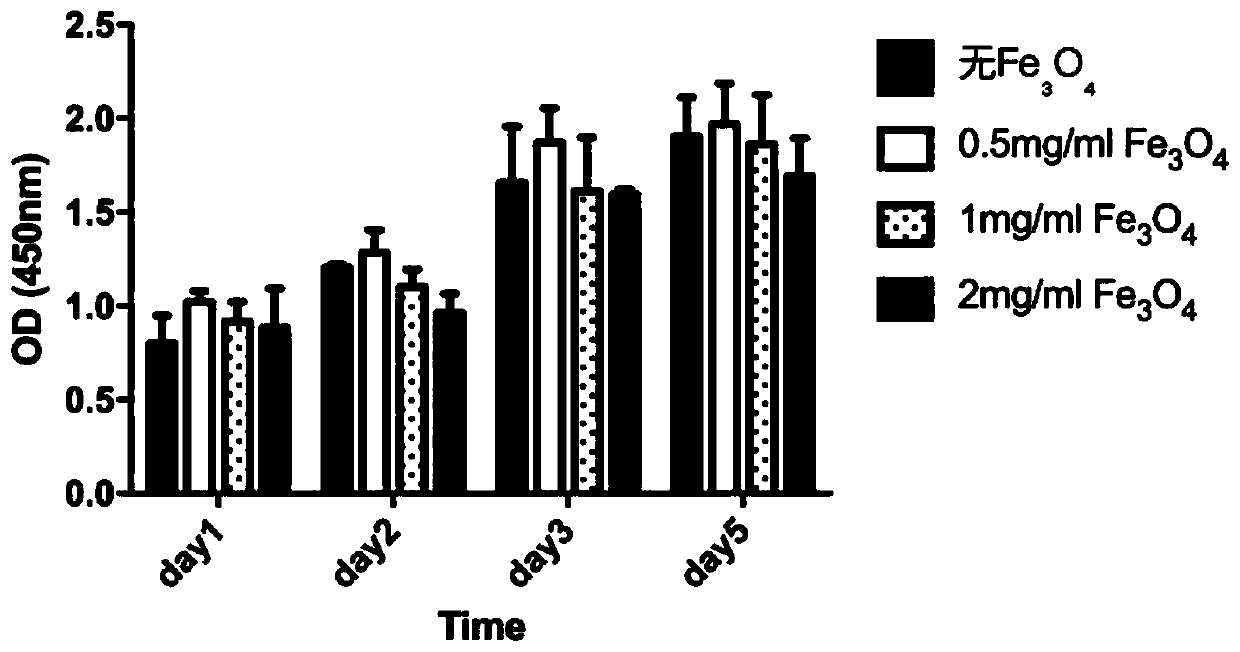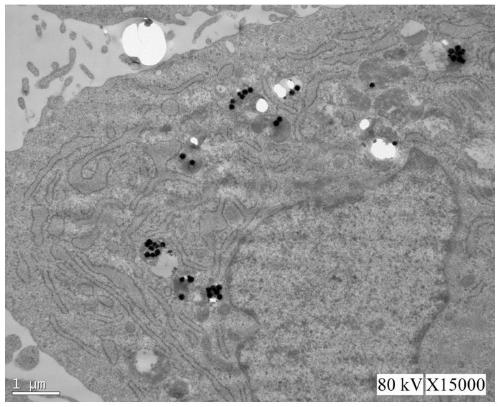Ferroferric oxide superparamagnetic nanoparticle stimulating stem cell for exosome osteogenesis
A superparamagnetic and nanoparticle technology, which is applied in the field of nanomaterials and biomedicine, can solve the problems of seed cell apoptosis, poor osteogenesis effect, poor stability, etc.
- Summary
- Abstract
- Description
- Claims
- Application Information
AI Technical Summary
Problems solved by technology
Method used
Image
Examples
Embodiment 1
[0041] Embodiment 1 The cultivation of bone marrow mesenchymal stem cells (BMSCs)
[0042] The human bone marrow mesenchymal stem cells used in the experiments of the present invention were purchased from Shanghai Youyu Biotechnology Co., Ltd.
[0043] The BMSCs cells were subcultured with low-sugar DMEM medium containing 10% fetal bovine serum at a ratio of 1:3 to obtain the first generation of bone marrow mesenchymal stem cells, and continued to be subcultured to the third generation of bone marrow mesenchymal stem cells. In this experiment, the cells of passage 3-5 were selected for subsequent experiments.
Embodiment 2
[0044] Example 2 CCK-8 detects Fe 3 o 4 Toxic to bone marrow mesenchymal stem cells
[0045] The 3rd-5th generation BMSCs were inoculated in 96-well plates, and the planting density of the cells was 1×10 4 / well, after 2 days of culture, replace with Fe 3 o 4 culture medium, adding concentrations of 0mg / ml, 0.5mg / ml, 1mg / ml, 2mg / ml Fe 3 o 4 , treatment 5d, using the CCK8 method for Fe 3 o 4 Cells treated for 1d, 2d, 3d and 5d were tested for toxicity. Add 10 μL of CCK8 solution and 90 μL of DMEM medium to each well, and measure the absorbance of each well with a microplate reader, and the absorption wavelength of the CCK8 solution is 450 nm.
[0046] CCK8 cytotoxicity experiments found that using a concentration gradient of 0-1mg / ml Fe 3 o 4 There is no obvious toxic effect on BMSCs, Fe at a concentration greater than 1mg / ml 3 o 4 have a certain effect on cell proliferation ( figure 1 ).
Embodiment 3
[0047] Example 3 Fe 3 o 4 Superparamagnetic nanoparticles stimulate exosomes from bone marrow mesenchymal stem cells
[0048] Take the well-grown BMSCs of the 3rd-5th generation and press 1×10 5 Seed in a 6-well plate at a density of 6 wells. When the cell fusion rate reaches 70-80%, divide the cells into 2 groups: control group and Fe 3 o 4 treatment group. Control group: cultivated with 10% fetal bovine serum low-sugar DMEM medium; Fe 3 o 4 Treatment group: Fe 3 o 4 Superparamagnetic nanoparticles (Nanjing Xiaoli Biology) were dissolved at 1 mg / ml in low-sugar DMEM culture medium containing 10% fetal bovine serum by volume, and the cells were cultured.
[0049] 1. Observation of Fe by transmission electron microscope 3 o 4 Mark BMSCs cells:
[0050] Fe 3 o 4 Treated BMSCs at 37°C, 5% CO 2 Cultured in an incubator for 48 hours, digested with 0.25% trypsin at 37°C for 1 minute, centrifuged at 120 g for 5 minutes, washed twice with PBS, fixed with 2.5% glutaraldeh...
PUM
| Property | Measurement | Unit |
|---|---|---|
| Diameter | aaaaa | aaaaa |
Abstract
Description
Claims
Application Information
 Login to View More
Login to View More - R&D
- Intellectual Property
- Life Sciences
- Materials
- Tech Scout
- Unparalleled Data Quality
- Higher Quality Content
- 60% Fewer Hallucinations
Browse by: Latest US Patents, China's latest patents, Technical Efficacy Thesaurus, Application Domain, Technology Topic, Popular Technical Reports.
© 2025 PatSnap. All rights reserved.Legal|Privacy policy|Modern Slavery Act Transparency Statement|Sitemap|About US| Contact US: help@patsnap.com



